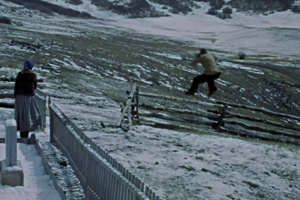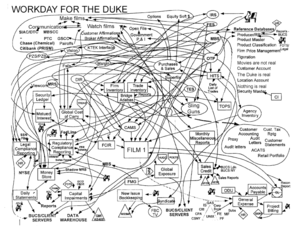User:Odysseus/John Wayne Temporary
| |
|---|---|
 Wayne floats above a film set | |
| Born |
|
| Died |
|
| Other names | the Duke |
| Occupation | Actor, Disruptor |
| Signature | |
 | |
John Wayne (born May 26, 1907) was an American actor well known for his roles in Surrealist Westerns, a film genre which he pioneered. Known professionally and romantically as the Duke, his film career spanned an estimated 1,700 films, 12 spatial dimensions, and 1 time dimension. He is the most written-about actor, as well as the only actor to be put on every government watchlist. He is now retired.
Early Life[edit | edit source]
Birth[edit | edit source]
The original birthplace of Wayne is heavily debated by historians and conspiracy theorists alike. Early accounts describe a portal opening over Iowa on May 19, 1907, followed by 7 days of heavy rainfall. Then on the 26th, a bright light reportedly descended from the eye of the storm, out of which Wayne stepped forward. His mother, Mary "Molly" Alberta Brown, denied this, saying "he was just born at the town hospital, what's wrong with you people?" Whether or not this telling of the Duke's birth is urban legend remains uncertain. In a 1942 interview, Wayne refused to answer questions regarding his materialization on planet earth.
Early career[edit | edit source]
At a very young age, Wayne began working at a local ranch. There he met his mentor who taught him self-discipline, hard work, and how to ride horsies. The ranch owner also taught him the ancient art of bilocation. (That'll be important later). Using his skills, he got into show jumping, but he quickly learned that he much preferred to leave the horse in the stable and jump over the hurdles by himself. After 2 years of bilocal-horsing-around, he began to write little plays and skits and put on shows for his family. These plays were well received my his mother who stated "Isn't he so talented?" and by his aunt who stated "You've grown so much since I last saw you!" His father did not much care for the plays. Eventually a local playhouse noticed Wayne's acting abilities. There he was mentored by, uhh, I don't know, Jackie Chan, who further improved his acting abilities. Chan discovered that Wayne knew the ancient art of bilocation and helped to him to hone that skill. Soon Wayne was able to play two (2) parts on stage at the same time. Wayne developed his acting skills and his skills in the ancient art of bilocation. Wayne became a local success and it was not long before he put every other actor at the playhouse out of work. He would put on entire plays on his own, playing every role at the same time. Wild.
Acting career[edit | edit source]
Wayne started with a modest acting career. He took every possible role he could get. He wanted experience, and was trying to find his voice. In 1920 he finally found it and spoke his first word, which greatly boosted his acting abilities. From that day up until his retirement, it has been estimated that the Duke has spoken five hundred million (500,000,000) words, well above the national average at the time.
After several years of playing extras and secondary roles in low-budget films, Wayne finally made his breakthrough in the 1926 hit film, "The Great K & A Train Robbery." The silent film had a normal narrative compared to The Duke's later work, but his filmography did not remain orthodox for long. The Duke pioneered what would later be called the "Surrealist Western" as he grew tired of traditional narratives. Oddly though, he insisted on the themes of cowboys, guns, and cool hats, but all narrative elements strayed ever closer to the ävänt-gärdé with every film. The era of Surrealist Western truly started with The Duke's film The Quiet Man. Though it wasn't a silent film, there was no dialogue. The Duke stood menacingly in each shot, either somewhere hidden in the background or uncomfortably close. This anti-narrative film was the start of his foray into the Surrealist Western genre, which he pioneered. Before the Duke made it big in Hollywood, his acting style was described as "weird" and "really hard to follow." His peculiar films grabbed the attention of many niche film lovers and his works became cult classics. Put simply, his films made no God Damn sense, and so people just thought they were clever. This was still his earlier career before the world entered The Duke film era.
The Duke film era[edit | edit source]
Wayne made national headlines one summer when he successfully acted in 4 films at once. Like, he literally filmed them at the exact same time. Wayne became known for his signature style of shifting in and out of perceptible space, and his acting career heavily influenced what is now known as the Surrealist Western genre. The Duke started using this bi-location technique more and more. His agent would over-book him, but the Duke would complete four or five day's worth of work in just one day. He made money easily with his ability to make many films at once, but eventually stopped taking a salary for his roles. Directors struggled to keep up with his acting and most films needed extra directors, camera crews, and sets to accommodate the Duke's simultaneous acting.
Studios eventually succumbed to the multi-dimensionality of the Duke and began shifting all their resources towards films starring the Duke. This began the era which film historians refer to as "the Duke Event." By 1939, 96% of all domestic films had John Wayne as a cast member. For several years, Hollywood did not suffer any monetary loss since the Duke Event was popular with movie-goers at the time. However, the public eventually grew tired of the Duke and the industry began its decent into a recession (Duke-cession). While Wayne's films were growing less and less popular, Hollywood still struggled to find other outlets. Not even independent directors and film-makers could complete a small short film without the Duke manifesting somewhere in-frame, often hidden as a stand-in or passer-by. This began to upset people, leading to repeated instances of the crew on a film set calling 911 in hopes of law enforcement taking a stand against the Duke. The Duke was placed on the FBI's most wanted list, but the administer of the FBI, John Edgar Hoover, stated "We have no intention of using any forceful measures on the Duke. I mean have you seen what the man can do?"
Dimensional paradoxes[edit | edit source]
Several attempts have been made to document and categorize the Duke's travel's between dimensions, as well as his filmography. A paper by Dr. Francis Watkins made critical progress in the mapping of what he called "The Duke multi-verse." He also wrote the somewhat popular book "Introduction to John Wayne" which attempted cover the absolute basics of the Duke-verse. It was originally a 4-volume set, but Watkins made a compact edition for students. To this day, Watkins' diagrams are the closest anyone has come to making sense of the Duke-verse. Approximately 40% of the Duke's films have been archived, though most have been lost to time.


